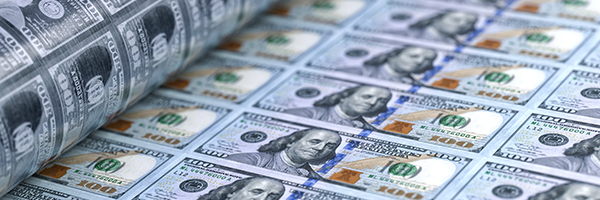
April 26, 2024 | Daily JAM, Mid Term, Morning Briefing |
Yesterday we had a report of core Personal Consumption Expenditure for March that showed core inflation ticking up to an annual rate of 3.8% from 3.7%. Core inflation, if you remember, looks at prices after excluding more volatile food and energy prices, The reasonable conclusion was that inflation was remaining stubbornly higher than the Federal Reserves % target. And that the first cut to interior rates from the Fed wouldn’t come until December, instead of July or September. Today we got the report on all-items PCE inflation.

February 29, 2024 | Daily JAM, Mid Term, Morning Briefing |
The headline, all-items Personal Consumption Expenditures price index, the Federal Reserve’s preferred inflation measure, climbed at a 2.4% year over year rate in January. That was in line with what economists had forecast and down from the 2.6% annual rate in December. The core PCE, that is after stripping out more volatile food and fuel prices, climbed at a 2.8% year over year rate. In December the annual rate of core inflation had been 2.9%. But that was the end of the good news in today’s PCE inflation report.

February 26, 2024 | Daily JAM, Morning Briefing, Short Term |
On Thursday the financial markets get a new monthly PCE inflation report. The PCE, Personal Consumption Expenditures index, is the Federal Reserve’s favorite inflation measure. And Thursday’s report on January inflation could be bad news for the financial markets,

January 25, 2024 | Daily JAM, Morning Briefing, Short Term |
U.S. Gross Domestic Product (GDP) grew at an annual 3.3% rate in the fourth quarter, the Commerce Department announced today. That was down from the 4.9% annual growth rate in the third quarter, but substantially above the 2.0% rate expected by economists. For the full year, the US.economy expend at a 3.1% rate.

October 27, 2023 | Daily JAM, Morning Briefing |
The Personal Consumption Expenditures index, the Federal Reserve’s preferred measure of inflation, accelerated to a four-month high in September. The core Personal Consumption Expenditures index, which strips out volatile food and energy prices, rose 0.3% in September from August, according to the Bureau of Economic Analysis. As with this week’s report of a surprisingly strong 4.9% annual GDP growth, the “culprit” in today’s surprise was strong consumer spending. Inflation-adjusted consumer spending jumped 0.4% last month. The numbers in this report for inflation and earlier this week for GDP growth argue that the Federal Reserve might consider another interest rate increase in the remainder of 2023. But Wall Street sentiment doesn’t agree with that view.

September 29, 2023 | Daily JAM, Morning Briefing |
The Federal Reserve’s preferred measure of inflation, the Personal Consumption Expenditures index (PCE) rose at the slowest monthly pace inAugust since late 2020. The core personal consumption expenditures price index, which strips out food and energy prices, climbed just 0.1% month to month in August, according to the Bureau of Economic Analysis today, Friday, September 29. The so-called super core inflation index for services, which has been on the Fed’s watch list lately, also posted the smallest monthly advance since 2020. The super core rate also strips out housing costs. That rate climbed by just 0.1% in August.

September 23, 2023 | Daily JAM, Short Term |
Expect dueling news watches this week. Garnering most of the pixels will be the countdown to a government shutdown if Congress doesn’t pass a stopgap continuing resolution to keep funding the federal government by September 30. Odds are good right now that the House of Representatives won’t meet the deadline and the many government departments will shut down next week. And on Friday, investors get the next release of the Federal Reserve’s favorite inflation series, the Personal Consumption Expenditures index.

May 26, 2023 | Daily JAM, Morning Briefing |
The personal consumption expenditures price index, the Fed’s preferred inflation gauge, rose a faster-than-expected 0.4% in April, the Commerce Department reported this morning, May 26. Core PCE inflation also rose by 0.4% in April. “This is the wrong direction for the Fed,” Diane Swonk, chief economist at KPMG, told Bloomberg. “June will depend on getting outside of debt ceiling issues but a July hike is now in play.”

April 28, 2023 | Daily JAM, Morning Briefing |
The headline Personal Consumption Expenditures index, the Federal Reserve’s preferred inflation measure, climbed at 4.2% in the year through March. That was a big drop from the 5.1% year-over-year rate in February. (Although, I’d note, economists were expecting this all items number to drop to 4% before the actual report.) But the core inflation rate, after stripping out more volatile food and fuel prices, hardly budged in March at 4.6% year-over-year from the 4.7% year-over-year rate in February. And it’s the core PCE inflation rate that carries the most weight with the Federal Reserve. In other words, inflation remains elevated and very, very sticky.

April 23, 2023 | Daily JAM, Morning Briefing, Short Term |
The Bureau of Economic Analysis is scheduled to report the Personal Consumption Expenditures index, the Federal Reserve’s preferred measure of inflation, on April 28. But because the Fed’s pre-meeting quiet period stretches from April 22 to May 4, there won’t be any comments from Fed officials to spin the data for the financial markets. That could be, well, awkward, since it will leave Wall Street more in the dark than usual about what the inflation results mean. The PCE index is expected by economists surveyed by Bloomberg to have fallen in March to a 4.1% annual rate from the 5% reported for February. If the inflation numbers come in on expectations, investors and traders will be left wondering if the drop is enough to lead the Fed to stop its interest rate increases after a 25 basis point boost at the May 3 meeting.

April 1, 2023 | Daily JAM |
Friday’s PCE (Personal Consumption Expenditures) index, the Federal Reserve’s preferred inflation, measure gave believers in Goldilocks just enough to keep the fairy tale alive. The all-items index rose 0.3% in February. That works out to a 5% annual rate. The month-to-month increase was less than expected by economists surveyed by Bloomberg–who were looking for 0.4%. The core index, which excludes food and energy prices, also rose by 0.3% month to month. Again less than expected. That put the annual core inflation rate at 4.6%.

March 25, 2023 | Daily JAM, Short Term |
Look for another inflation report this week. This time–on March 31–it’s the Federal Reserve’s favorite inflation model, the Personal Consumption Expenditure (PCE) index. And, there’s potential trouble in this report–if projections from the Cleveland Federal Reserve Bank’s Inflation NowCast are accurate.








